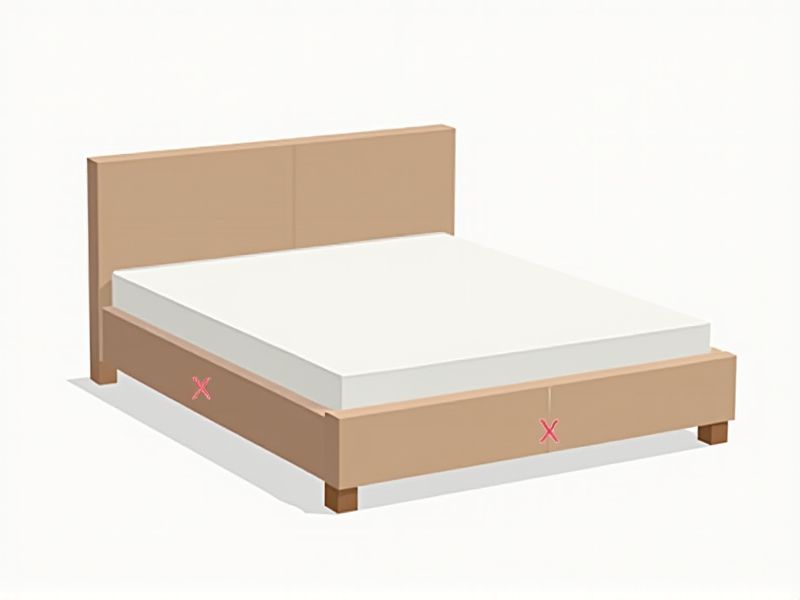
A standard full bed, also known as a double bed, typically measures 54 inches wide by 75 inches long (137 cm by 191 cm). This size offers more width than a twin bed, making it a comfortable option for single sleepers who want extra space or for cozy guest rooms. However, it can feel a bit tight for two adults sharing it regularly, especially compared to a queen size bed. When considering a full bed, make sure to measure your room to ensure it fits comfortably with other furniture.
Width: 54 Inches
A standard full bed measures 54 inches in width, providing ample space for individuals or couples. This size is ideal for bedrooms requiring a balance between space efficiency and comfort, accommodating two adults comfortably without overwhelming smaller rooms. In terms of length, a full bed typically extends to 75 inches, offering sufficient legroom for most sleepers. Choosing a full bed can enhance your sleeping experience while maximizing your room's available area.
Length: 75 Inches
A standard full bed measures 75 inches in length, providing ample space for a single sleeper or a cozy fit for two. With a width of 54 inches, this size is ideal for various room dimensions, making it a versatile option for your home. The full bed is often chosen for guest rooms, offering comfortable accommodation that balances space and comfort. By selecting a full bed, you ensure a practical solution that meets both your size requirements and sleeping preferences.
Mattress Height: 8-12 Inches
A standard full bed typically accommodates a mattress height ranging from 8 to 12 inches, providing comfort and support for a variety of sleepers. Choosing a mattress within this height range can enhance your sleeping experience by promoting proper spinal alignment and reducing pressure points. When considering a full bed frame, ensure it is compatible with these mattress dimensions for optimal stability and performance. Investing in quality bedding that meets this standard can significantly improve your overall sleep quality.
Bedding Compatibility
A standard full bed measures 54 inches wide by 75 inches long, making it essential to choose bedding that fits these dimensions for optimal comfort. Look for fitted sheets with deep pockets to accommodate mattress thicknesses ranging from 8 to 14 inches, ensuring a snug fit without slipping. Consider the thread count of sheets; a higher thread count, typically ranging from 300 to 800, enhances durability and softness, offering a more luxurious feel. Pillowcases and duvet covers should also match the full bed's dimensions, with standard or queen sizes commonly used for pillows, ensuring a cohesive bedding aesthetic.
Room Size Requirement
A standard full bed typically measures 54 inches wide by 75 inches long, making it suitable for rooms with at least 10 by 12 feet of space to ensure adequate movement and comfort. This size is ideal for young adults or couples who prefer a cozy but spacious sleeping arrangement. When considering furniture layout, you should account for additional space for nightstands or other essential items. Optimizing your room's configuration can enhance both functionality and aesthetics.
Double Bed Category
A full bed, often referred to as a double bed, typically measures 54 inches wide by 75 inches long, providing ample space for one person or a snug fit for two. This standard size makes it an ideal choice for smaller bedrooms or guest rooms, accommodating various mattress types, including innerspring, memory foam, and latex. With a wide range of designs available, you can personalize your space to match your aesthetic preferences while ensuring comfort. The full bed's versatile dimensions allow for creative use of bedding and accessories, enhancing the overall ambiance of your bedroom.
Box Spring Support
A standard full bed typically measures 54 inches in width and 75 inches in length, providing ample space for single sleepers or couples. A box spring plays a crucial role in supporting a full bed, acting as a foundation that enhances mattress durability and comfort while also elevating the sleeping surface. Most box springs designed for full beds are 4 to 9 inches high, which can significantly impact your overall bed height and feel. Ensuring that your full bed has a compatible box spring will not only improve sleep quality but also extend the lifespan of your mattress.
Frame Dimensions
A standard full bed frame typically measures 54 inches in width and 75 inches in length. This size is designed to accommodate two adults comfortably, offering a balance between space-saving and comfort. When selecting a full bed frame, consider a minimum clearance of 6 inches from the floor to allow for under-bed storage solutions. A sturdy construction, often made from wood or metal, is essential for durability and support.
Weight Capacity
A standard full bed typically measures 54 inches in width and 75 inches in length, providing a spacious sleeping surface for individuals or couples. When considering weight capacity, most full beds can support between 400 to 600 pounds, depending on the frame's materials and design. High-quality frames, constructed of solid wood or metal, generally offer enhanced durability and stability, ensuring adequate support. If you prioritize weight capacity, always check the manufacturer's specifications to ensure it meets your needs for a comfortable sleep experience.
Material Options
When selecting a full bed, consider various material options that enhance durability and comfort. Solid wood, such as oak or maple, provides longevity and a classic aesthetic, while engineered wood can be an economical alternative without sacrificing strength. Upholstered beds, featuring fabrics like linen or velvet, offer warmth and a touch of luxury, making them a popular choice for modern bedrooms. Metal options, typically made from steel or iron, provide a sleek, contemporary look and are often lighter, making assembly and movement easier.
